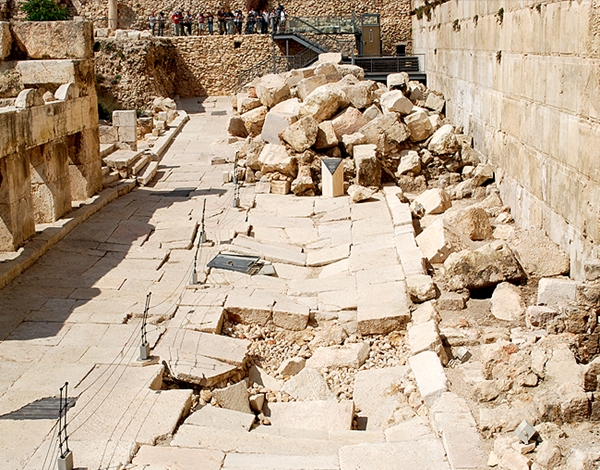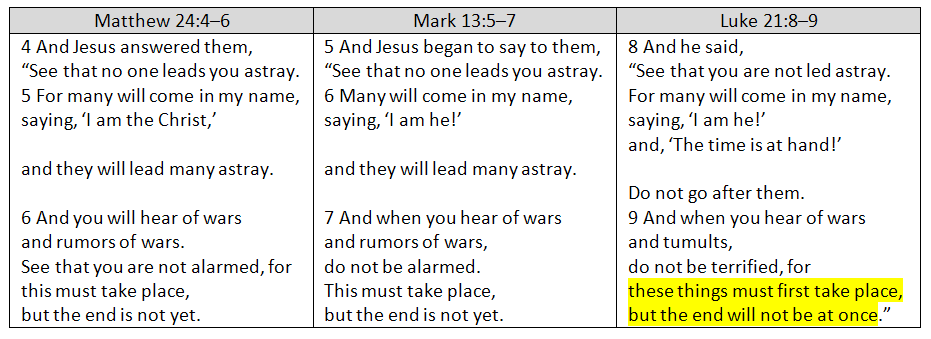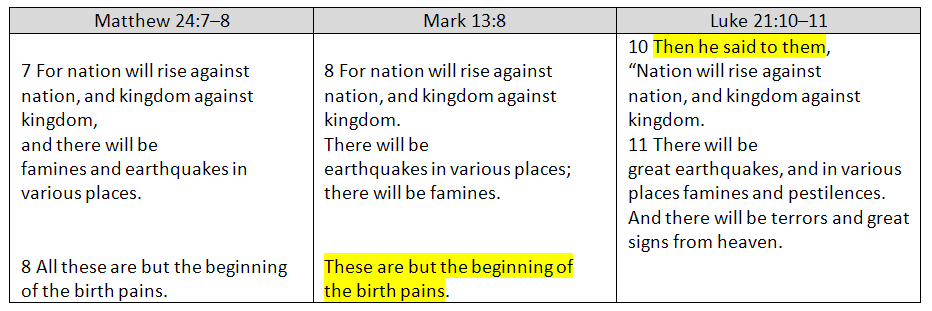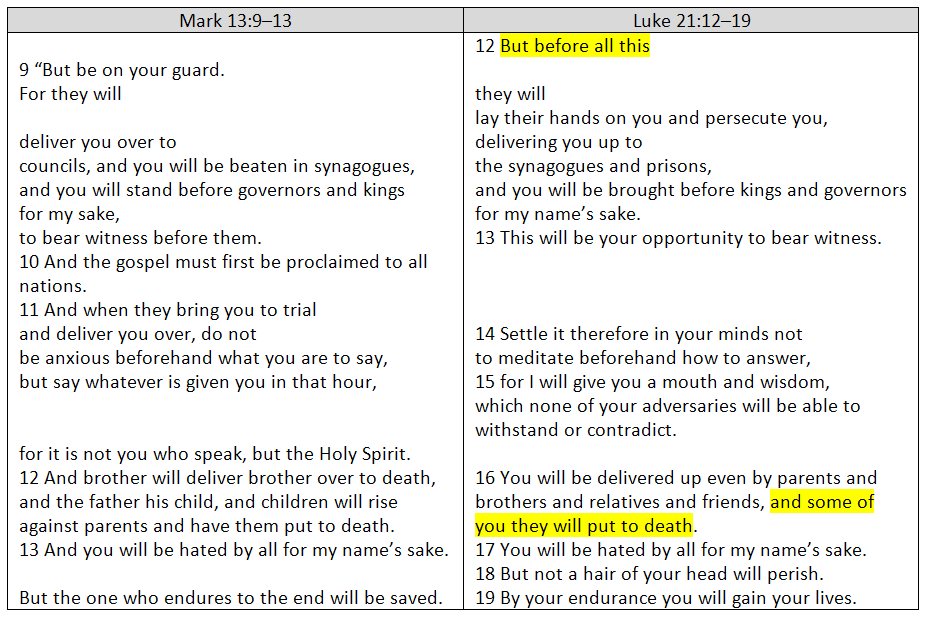The Olivet Discourse
1) What is the Olivet Discourse?
A) |
The “Olivet Discourse” is the name given to a private conversation Jesus had with His disciples (Peter, James, John and Andrew) three days before He died on the cross. It took place on the Mount of Olives, a mountain ridge covered with olive trees that runs along the eastern side of Jerusalem. |
B) |
In this conversation, Jesus gave a sweeping overview of the future from the destruction of Jerusalem in AD 70 to His own return at the end of the Tribulation. Jesus concluded by urging His disciples to “stay awake, for you do not know on what day your Lord is coming” (Matt 24:42). Jesus’ point is clear—prophecy is designed to change our hearts, not simply fill our heads with facts about the future. The Son of Man is coming back to judge sinners and reward the faithful. We must be ready for His return! |
2) Outline and Content of the Olivet Discourse.
A) |
Historical Setting. |

1) |
As Jesus left the Temple complex, His disciples marveled over its grandeur. The beautiful buildings were the result of a renovation project begun by Herod the Great in 20 BC. He rebuilt the second Temple from the foundations up, doubled the size of the Temple Mount and added impressive new structures—the Antonia Fortress to the north and the Royal Stoa to the south. At that time, construction had been underway for over 50 years, and it would continue for another 34 years until the Jewish revolt in AD 64. |
2) |
The stones which impressed the disciples were indeed magnificent, and some of them are still visible in the retaining walls today. These “Herodian Stones” are huge, each measuring ten to twelve feet in length and weighing many tons. One foundation stone discovered in the western retaining wall measures 45 feet long by 11 feet high by 15 feet wide. It weighs nearly 600 tons. |
3) |
To the amazement of His disciples, Jesus responded by predicting the destruction of the Temple: “there will not be left here one stone upon another that will not be thrown down” (Matt 24:2). This was fulfilled in AD 70 when the Romans destroyed Jerusalem and set the Temple on fire. There were large quantities of gold in the Temple, and much of it melted and seeped into the crevices between the stones. When the ruins cooled down, the Romans systematically removed everything, stone by stone, in order to get to the gold that had solidified inside the crevices (the picture below shows some of the rubble the Romans left behind in the street along the western side of the Temple Mount). |

B) |
Three Questions. |

1) |
The thought of the Temple being destroyed was very disturbing to Jesus’ disciples. They couldn’t imagine such a thing happening apart from the end of the age and the coming of the Messiah in judgment (cf. Zech 12–14). Peter, James, John and Andrew asked Jesus privately when His prediction would come to pass. They asked three questions which, at the same time, included requests for three signs. These questions were: |
|
2) |
Jesus answered all their questions, but not in the same order as they were asked. Instead, He answered Q3 first, Q1 second, and Q2 last. Matthew, Mark and Luke record the answers to Q2 and Q3, while only Luke records the answer to Q1. |
C) |
General Characteristics of the Present Age (Q3 answered negatively). |

1) |
As He began to answer His disciples’ questions, Jesus wanted to make sure they would not be led astray, and so He answered Q3 negatively, that is, He told them about events that were not signs of the end of the age: the rise of false messiahs and the scourge of local wars. Jesus said, “these things must first take place, but the end will not be at once” (Luke 21:9b). |
D) |
Signs of the End of the Age—Events Prior to the Tribulation (Q3 answered positively). |

1) |
Jesus now answered Q3 positively, telling His disciples about the events that would be the sign of the end of the age: |
a) |
“Nation will rise against nation, and kingdom against kingdom”—the wording here echoes Isaiah 19:1–2 and 2 Chronicles 15:5–6 where it is used to indicate that a particular region was completely engrossed in conflict. The context suggests that this particular conflict will be global in scope (cf. Matt 24:14). |
b) |
“Earthquakes, famines, pestilences”—all these have occurred regularly since the Flood, but they will intensify as the end approaches. |
c) |
“Terrors and great signs from heaven”—the appearance of comets in the sky has long been a source of fear, and as the age draws to a close, these will no doubt increase in frequency. Meteorite strikes may also increase—the impact from these celestial stones can be many times more powerful than an atomic bomb. |
2) |
Jesus said that these events “are but the beginning of the birth pains” (Mark 13:8). The phrase “birth pains” echoes Jeremiah 30:6–7 where the prophet speaks of the travail that will accompany the great “Day of the Lord” (cf. Jer 30:3, 7, 24). Since the ‘Day’ in “Day of the Lord” does not refer to an actual 24-hour day, but rather to a definite period of time, Jesus qualified His statement by saying that these signs are merely the “beginning” of that Day—they signify that it is about to begin.[1] |
E) |
Interruption—The Personal Experience of Jesus’ Disciples (leading up to Q1). |

1) |
In the middle of His answer of Q3, Jesus paused and turned the clock back to the present day: “But before all this” (Luke 21:12a). He then revealed to His disciples the persecution they would personally experience for the sake of the gospel. He told them not to expect the end of the age to come soon. In fact, Jesus predicted that some of them would be martyred before that time came (Luke 21:16). |
F) |
The Sign of the Fall of Jerusalem (Q1 answered). |

1) |
After telling His disciples that they would suffer for the sake of the gospel, Jesus answered Q1. He told them that the sign of the imminent destruction of Jerusalem and the Temple would be the surrounding of Jerusalem by armies (Luke 21:20). History/tradition tells us that this prophecy was fulfilled in a remarkable way.[2] |
a) |
In AD 66, the Jews revolted against their oppressors, the Romans. Gaius Cestius Gallus, the Governor of Syria and commander of the 12th Legion, responded by marching his army to Jerusalem and surrounding the city. The surrounding of Jerusalem was the sign that Jesus had given, and the Jewish believers realized that Jerusalem would soon be destroyed. Jesus had commanded them to leave the city when they saw this sign, but it was impossible to do so while the Romans were still outside. |
b) |
After a siege of only nine days, Gallus realized that his supply lines were vulnerable to Jewish attack. He didn’t have enough supplies on hand to maintain an extended siege, so he decided to fall back to the coast. During Gallus’ withdrawal, his column was ambushed near Beth Horon and suffered heavy losses. He escaped to Antipatris but not before he lost about 6,000 men and a large amount of war material. For the time being, Jerusalem was no longer surrounded by armies, and so the Jewish believers were able to leave the city. They crossed the Jordan River and set up a new community in the town of Pella. There they waited for Christ’s prophecy to be fulfilled. |
c) |
In the year AD 68, Vespasian and his son, Titus, besieged Jerusalem once again, and in the year AD 70, the city fell and the Temple was destroyed. All together, over a million Jews were killed in the final onslaught—but the Jewish believers who heeded Jesus’ warning were saved (the picture below is from the Arch of Titus—it shows captured Jews being paraded through the streets of Rome during Titus’ victory procession). |

2) |
Since that time, Jerusalem has indeed been “trampled underfoot by the Gentiles,” and continues to be so to the present day. Jerusalem will not be free of the oppression of Gentile nations until the Messiah returns (Zech 14:11). |
G) |
Signs of the End of the Age—The First Half of the Tribulation (Q3 continued). |

1) |
After interrupting His answer of Q3 to tell the disciples about the sign of Jerusalem’s coming destruction, Jesus continued His discussion of the signs which would herald the end of the age. In Matthew 24:7–8 Jesus spoke of the events which will precede the Tribulation. Now, in Matthew 24:9–14, Jesus described the first half of the Tribulation itself. The events immediately preceding the Tribulation and the events of the first half of the Tribulation form the complete answer to Q3—this entire group of events constitutes the sign of the end of the age. |
H) |
Second Half of the Tribulation (leading up to Q2). |

1) |
Having given a brief overview of the first half of the Tribulation (Matt 24:9–14), Jesus now connects His prophecy to Daniel’s 70th Week (cf. Dan 12:11 (LXX); also Dan 9:27). As we have seen in the lesson on Daniel, the 70th week of Daniel 9 corresponds to the seven-year Tribulation period. At the mid-point of the Tribulation, the Antichrist will reveal his true nature to the Jews. He will put a stop to the daily sacrifices and offerings, and he will erect an “abomination of desolation” (an idol) within the Tribulation Temple in Jerusalem. |
2) |
Jesus told His disciples that the desecration of the Tribulation Temple would be the sign of the beginning of the “great tribulation”—the last 3½ years of the Daniel’s 70th Week. Just as the surrounding of Jerusalem by armies in AD 66 meant that believers should flee to the mountains, so the “abomination of desolation” will mean that everyone should once again flee the city. Thus the events which form the sign of the end of the age culminate in the ‘super-sign’ of the “abomination of desolation.” |
3) |
Jesus went on to say that the second half of the Tribulation will be terrible—so terrible, in fact, that if the wrath of God was not cut short, everyone (saved and sinner alike) would be killed. “But for the sake of the elect those days will be cut short” (Matt 24:22). The “elect” refer to those who will be saved during the Tribulation (cf. Rev 7:9–17). |
4) |
False christs and prophets will continue to arise, and they will perform signs and wonders. But Christ will not yet appear. He will not return until the very end of the seven-year Tribulation period. |
I) |
Sign of the Second Coming (Q2 answered). |

1) |
Jesus now answered Q2—the sign of His coming will begin with the darkening of the sun, the moon and the stars. Then, with the suddenness and brilliance of lightning (Matt 24:27), the heavens will be ablaze with the glory of God—this is “the sign of the Son of Man” (Matt 24:30). Jesus will appear in the sky and everyone on earth will see Him. He will descend to the earth through the clouds and set His feet “on the Mount of Olives” (Zech 14:4). He will defeat the Antichrist and save both Jerusalem and the believing Jews (Zech 12–14; Rev 19:11–21). |
2) |
At this point in the conversation, Jesus had answered all three questions: |
a) |
Q1—“When will Jerusalem and the Temple be destroyed, and what will be the sign that it is about to occur?” |
b) |
Q2—“What will be the sign of your coming?” |
c) |
Q3—“What will be the sign of the end of the age?” |
J) |
The Gathering of the Elect (after Q2). |

1) |
Jesus’ statement about the gathering of the elect by the angels echoes Deuteronomy 30:4 and Ezekiel 11:17. In the OT “to scatter to the four winds”[3] or “to regather from the four winds” / “from every country” / “from the extremities of the earth”[4] are recurring expressions. The first refers to the dispersion of the Jews because of their persistent rebellion against God; the second announces the regathering of the Jews to Israel, and a return of national and spiritual unity. The scope of this gathering is universal, for Mark’s formula “from the ends of the earth to the ends of heaven” combines two OT expressions which mean “everywhere.” |
K) |
Parable of the Fig Tree (a message for believers in the Tribulation). |

1) |
This parable has been misunderstood and misused by many who have tried to set a date for the Rapture and the Second Coming. Such people claim that the “fig tree” stands for the reestablishment of the State of Israel in 1948. This, they say, began the timetable for the “generation” who will “not pass away until all these things take place” (Matt 24:34). If you could figure out how long a “generation” is, they claim, you will know when the Rapture is about to take place. |
2) |
This view is a misinterpretation. If the “fig tree” represents the State of Israel, then what do “all the trees” represent (Luke 21:29b)? Jesus was not using the trees as prophetic types. He was simply referring to them as what they are: trees. The point of the illustration is this: When the fig tree and all the other trees begin to blossom, it is a sure sign that summer is on its way, because the blossoming occurs in the spring. In the same way, Jesus said, “when you see these things taking place, you know that the kingdom of God is near.” The “things” that Jesus was speaking of are the events of the Tribulation in general, and the “abomination of desolation” specifically. The generation of people who are alive to witness those events will not pass away before Jesus returns. They will be there when the Messiah comes in all His glory. Thus “this generation” refers to the elect who live through the Tribulation period. |
L) |
Time of Daniel’s 70th Week Unknown (a message for believers in the present age). |

1) |
The Second Coming of Christ will be preceded by the seven-year Tribulation period known as Daniel’s 70th Week. However, no one knows when that seven-year period will begin. It may begin next week, next year, or in a hundred years. Our responsibility is to be ready and to be busy about the Father’s business. |
M) |
Conclusion of the Olivet Discourse (how Jesus’ prophecy should affect our lives). |
1) |
Stay Awake! (Matt 24:43–44; Mark 13:34–37; Luke 21:34–36). |
a) |
The time before the Rapture of the Church and the beginning of the Tribulation will be a time of dissipation and drunkenness. The cares of this life will cause many to fall into a stupor (Luke 21:34–36). Jesus’ message to us is—Stay awake! |
2) |
Be Faithful! (Matt 24:45–25:30). |
a) |
The parables of the wise and wicked servants, the wise and foolish virgins, and the servants with the talents are all illustrations of the kind of faithfulness that Jesus expects of His disciples. We are to be faithful while we wait for our Master to return, and we should be working hard to bring others into the kingdom. |
3) |
Prepare for Judgment! (Matt 25:31–46). |
a) |
The Olivet Discourse ends with Jesus telling His disciples about the final judgment at the end of the Tribulation. Those who believe will enter into eternal life, and those who do not will enter into eternal punishment. We must prepare ourselves for judgment, for it will surely come to pass. In the meantime, let’s be feeding the hungry, welcoming the stranger and caring for the sick. When we do, we do these things to Jesus Himself! |

[1] There is debate about whether Matthew 24:4–14 refers to the time leading up to the Tribulation or to the first half of the Tribulation itself (or both). Personally, I take Luke’s divisional break in Luke 21:10 (“Then he said to them”) as an indication that Jesus had transitioned from speaking about the general characteristics of the current age (Matt 24:4–6) to the signs that herald the beginning of the Tribulation. Thus Matthew 24:7–8 are events which take place just before the beginning of the Tribulation, and Matthew 24:9–14 are events which take place in the first half of the Tribulation itself. For a summary of this debate, see J. B. Hixson, “The Olivet Discourse in the History of Dispensational Thought,” (Unpublished paper, Ph.D. Studies, Baptist Bible Seminary, August 2003).
[2] Eusebius, Ecclesiastical History III.5.3; Epiphanius, Treatise on Weights and Measures 15. See also “Pella, Flight to” in Ralph P. Martin and Peter H. Davids, eds. Dictionary of the Later New Testament & Its Developments (Downers Grove, Ill: Intervarsity, 1997).
[3] Jer 9:15; 18:17; Ezek 5:10, 12; 12:14; 17:21; Zech 2:10.
[4] Deut 30:3–4; Isa 11:12; 27:13; 56:8; Jer 23:3; 29:12; 31:8; Ezek 11:17; 20:34, 41; 28:25; 34:13.
[5] As we discussed in the lesson on the Rapture, the context of these verses is the physical return of Christ to earth (the Return), not the Rapture. Thus the idea of “taken” is in reference to judgment and corresponds to “swept away” in v. 39 (cf. Luke 17:34–37 as a clarification on this same topic). For more detail, see Larry D. Pettegrew, “Interpretive Flaws in the Olivet Discourse,” TMSJ 13.2 (Fall 2002): pp. 187–188.

